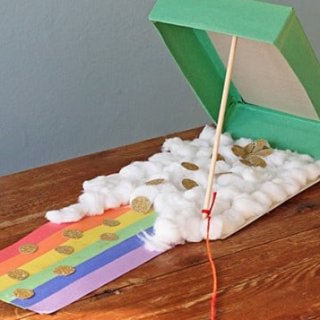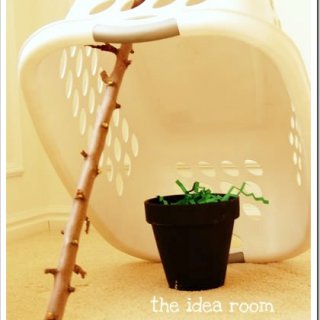The anatomy of an effective leprechaun trap plus 10 amazing leprechaun traps to get you started.
St. Patrick’s Day is a great holiday to just have fun with your kids. I used to feel like it was a no-pressure holiday. Throw some green clothes on, maybe dye the milk green. Fun.
Of course then things had to get complicated. My son came home from preschool talking about Leprechaun Traps. Um, excuse me? What is that?
At the time I had one-year-old twins at home and I did not have time to be building some sort of contraption. So we didn’t make one. (We did discover other fun activities, like Leprechaun Snow!)
But now my kids are older, and I admit I am intrigued by the idea of building a leprechaun trap. It could be a really great learning activity and STEM project overall. I’ve had some interesting thoughts on the topic, so here is the anatomy of an effective leprechaun trap. Plus get 10 of the best traps out there to try at home.

What's In This Post?
- Before You Make Your Leprechaun Trap
- Why Make a Leprechaun Trap?
- The 4 Main Components of a Quality Leprechaun Trap
- Parent’s Job
- Enjoy the Engineering Challenge!
- The Best Leprechaun Traps
- How to Build a Leprechaun Trap
- Lego Leprechaun Trap
- Leprechaun Trap Ideas
- Cereal Box Leprechaun Trap: a fun St. Patrick's Day craft for kids
- Gold Slime for St Patricks Day
- Under The Rainbow Leprechaun Trap
- Rooftop Garden Leprechaun Trap
- Ultimate Leprechaun Trap With Demonstration Video
- Leprechaun Trap Cake
- How To Trap a Leprechaun
Before You Make Your Leprechaun Trap
Before we even get started looking into the anatomy of a sold trap, I do want to reiterate one thing. All these little holiday activities are supposed to be fun. And if they are just stressing you out, don’t do them.
My children weren’t hurt because we didn’t make one of these until this year. I was less stressed because I cut out things that didn’t benefit our family. So do not feel pressure to do all the things for every little event with your kids.
That being said, if you think this will be fun and educational for your kids, let’s do it.
Why Make a Leprechaun Trap?
Why is it a potentially really good idea to make a leprechaun trap? I mean, you aren’t actually going to catch a leprechaun. (Wait, has anyone? Please let me know if one has been found. For scientific curiosity, of course, not to get gold. 😉 )
Making a device like this is a wonderful engineering project for kids! It practices problem-solving and creative thinking. And it is a great way to practice setting up an experiment. You’ll have to test your trap after all.
This is an activity you will want to get your child’s input on, and make them do as much as you can! This should be their project to maximize learning.
The 4 Main Components of a Quality Leprechaun Trap
While it is important for your child to do the bulk of the leprechaun trap design and construction, they might need some guidance. (And honestly, I needed some at first too!)
Through my research (also known as frantic Googling and Pinteresting) I have found that a solid trap needs 4 main components. You can help guide your child through some of these ideas if they need help.
Part One: Containment
The main part of your trap needs to be the leprechaun containment system. In other words, what is your leprechaun going to sit in once trapped?
You need something that your leprechaun can’t climb back out of or something that will hold your leprechaun in place until you can retrieve it.
Options to consider:
- tissue box
- bucket
- cereal box
- amazon box
- really any kind of box
- large oatmeal cannister
- large Tupperware
- storage bin
- paper towel tube
- plastic cup
The main things to ask your kids are:
- Are there any holes your leprechaun can escape through?
- Is it sturdy enough?
- Can your leprechaun lift it up?
- Is it big enough? (I honestly have no idea how large a leprechaun is, but if they are much bigger than a tissue box or cereal box I don’t think I want to catch one after all…)
Part Two: The Entrapment
You have your containment system, but how is the trap going to be activated? You can’t just put a bucket out and hope your leprechaun jumps in. How can you trick them?
This is a fun part for creative thinking. How are you going to get the leprechaun into the containment system?
One good option is to have the leprechaun fall into the trap somehow. This can be achieved by creating a false floor over the opening to the trap. The leprechaun walks across it, falls in, and can’t get back out. (This is one of the easiest options, perfect for the littlest engineers.)
Another idea is to find a way for the containment to cover the leprechaun so it can’t get out. This requires a bit more engineering. Do you use a stick and box method with a stick holding up the box so you can go under it? Once the leprechaun is in the trap the stick comes out and the trap closes. Or perhaps create some sort of pulley system that will lower the box into place?
Don’t forget to consider ladders or other creative ways to get your leprechaun to the trap. Legos can be used to build stairs. You can disguise the path as a rainbow. Maybe even build a ramp for the leprechaun to follow up.
This is a great time to let your kids play around with different options. Try a few things and see how they work.

Part Three: The Lure
Once you have figured out the logistics of how your trap actually works, you need to find a way to get the attention of a leprechaun. What will make them want to get close enough to be trapped?
You need a lure.
Ask your trap builder, what attracts a leprechaun? Think about all the obvious St. Patrick’s Day tropes. Gold coins, rainbows, and more. Here are some ideas to start you off.
- Gold
- Gold Coins
- Rainbows
- Pots of Gold
- Shamrocks
- Leprechaun Hats
- Four Leaf Clovers
- Horse Shoes
- Lucky Charms Cereal
- Lots of Green
- Green Glitter (if you feel like living dangerously)
Whatever your child thinks will attract the leprechaun will work.
Part Four: The Aesthetics
A leprechaun trap has to look good. Now is the time to unleash your little one’s creativity and let them have fun!
A common thought is that leprechauns are attracted to bright green, rainbows, and really anything that looks like it would be fun for St. Patrick’s Day.
This is a great time to get out your craft supplies and let your child take over. They can wrap their trap in tissue paper or paint it. Draw rainbows or use pipe cleaners to make a rainbow over the trap. (Cotton balls make great clouds for your rainbow too.)
Ask your child if they need to lay a trail for the leprechaun to follow. Maybe some gold or treats for the leprechaun to eat. Glitter could help as well.
If you are making traps with older children you can try a different tactic. Can you camouflage the trap so the leprechaun just stumbles into it? Maybe hide it on a table or behind a chair. Ask them what they think is the best way to catch the leprechaun.
Parent’s Job
Once you have the trap set, it is time to decide your role as a parent here.
Now, I am going to assume you will not catch a real leprechaun. (Not trying to be a downer, just going off of realistic odds.) It could be fun to spring the trap and leave a note for your kids from the leprechaun thanking them for the lure.
You can get as into it as you are feeling. There is no right or wrong way to do this.
Enjoy the Engineering Challenge!
The most important part of this activity is to have fun. And even if you create a trap that has no chance of actually catching anything, some real learning is happening.
Encourage your child to think through their process. Let them try whatever ideas they think will work. Let them decorate as they see fit. They are learning more than you know.
Good luck, and let me know if you catch anything.

The Best Leprechaun Traps
Building a leprechaun trap can be a lot of fun for kids, and it is a great chance to work on engineering skills! Creative thinking, problem-solving, and logic are all a part of the process.
This post gives you the anatomy of a quality leprechaun trap. If you need more specifics, check out these amazing traps.
How to Build a Leprechaun Trap
This is a traditional leprechaun trap to get you started.
Lego Leprechaun Trap
I love using legos for projects. Handy and a great for learning.
Leprechaun Trap Ideas
This post has all kinds of creative looking traps. Get inspired to decorate your own leprechaun trap here.
Cereal Box Leprechaun Trap: a fun St. Patrick's Day craft for kids
This is a classic set up with a super cute lure.
Gold Slime for St Patricks Day
If you don't feel like building a whole trap, you can try something different. Sticky slime that the leprechaun won't be able to get out of!
Under The Rainbow Leprechaun Trap
Cute and creative and a great way to practice colors when you build your rainbow.
Rooftop Garden Leprechaun Trap
This trap has adorable creativity and shows us we can think differently about how we set up our lure.
Ultimate Leprechaun Trap With Demonstration Video
This post has a helpful video. It also works physics a little more by utilizing a mouse trap!
Leprechaun Trap Cake
A cake trap is a bit more work, but I support any reason to make a cake.
How To Trap a Leprechaun
I like this one because it shows you don't have to go nuts with the decor to make a solid trap. Simple at-home items can work just as well.
















Natasha Wing
Friday 13th of March 2020
Shared this on my FB author page! In The Night Before St. Patrick's Day there's a double-page spread of leprechaun traps. Got the idea from teachers at a school I visited.
Kim
Friday 13th of March 2020
Thank you for sharing! It can be so much fun to make these traps. :)
Phillis
Tuesday 10th of March 2020
Love the ideas. I’m helping my 6-year-old grandson build a trap. He is so excited. Plan to dye the milk green, leave Green “pee” in the toilet and then the leprechaun will lose his hat when he “escapes.” Fun, fun.
Kim
Tuesday 10th of March 2020
Sounds like fun! I love the idea of the leprechaun losing his hat. So cute!